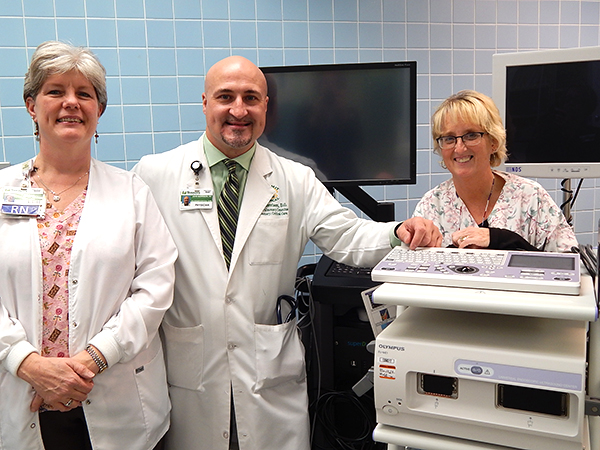Physicians Regional Medical Center Now Offers Advanced Diagnostic Capabilities to Detect Lung Cancer
New Technology Allows Physicians To Biopsy Hard-To-Reach Lesions

John Morrison, D.O., and Endoscopy Lab team at Physicians Regional Medical Center are utilizing new technology that benefits patients who may have lung cancer. (l-r) Nancy Tatum, RN, staff nurse; Dr. Morrison; Jannelle Justice, RN, charge nurse
A minimally-invasive diagnostic procedure called Electromagnetic Navigation Bronchoscopy (ENB) is now available at Physicians Regional Medical Center for patients who have hard-to-reach lesions on their lungs. It is used in combination with the latest technology for diagnosing and staging lung cancer, the endobronchial ultrasound (EBUS) transbronchial needle aspiration (TBNA) or EBUS-TBNA System.
To reach the lungs, a doctor typically inserts a thin, flexible tube called a bronchoscope into the patient’s nose or mouth. The tube is passed down the throat into airways. However, two-thirds of all lung lesions are outside the reach of a typical bronchoscope.
ENB starts where the bronchoscope ends. It combines GPS-like technology with a catheter-based system to extend the reach of the bronchoscope to regions deep in the lung. ENB’s unique approach lets physicians navigate to the boundaries of the lungs using the patient’s natural airway for access. As a minimally-invasive procedure, it increases the chances that patients can safely get a diagnosis, so that treatment — if needed — can begin.
Other methods to reach lesions deep in the lungs – outside the range of a bronchoscope – are more invasive and therefore have more risks for patients. These options include major surgery and Transthoracic Needle Aspiration (with the help of a CT scan), where a needle is inserted between the ribs and into the lung tissue. Another option is “watchful waiting” for patients with small lesions, in order to avoid a surgical procedure on a lesion that may be benign.
Doctors at Physicians Regional use ENB with the endobronchial ultrasound (EBUS) transbronchial needle aspiration system. The EBUS-TBNA System’s innovative design features ultrasound imaging capability and a dedicated aspiration needle that is specifically designed for diagnostic biopsies and staging in the lung. The EBUS scope offers real-time imaging and allows the physician to confirm the exact position of the needle. The needle itself has a specially designed “dimpled” tip, which enhances the view of the needle on the ultrasound image, making it easier to position it for biopsy.
Unfortunately, only 16% of lung cancer is diagnosed at its earliest and most curable stage, and more than 51% of cases are diagnosed after the cancer has metastasized. With EBUS, it is now possible to diagnose lung cancer more accurately for all lung cancer patients, not just those with hard-to-reach lesions. Using EBUS as a diagnostic tool provides several benefits over conventional, more invasive surgical biopsy procedures, including fewer complications and ease of scheduling as an outpatient procedure.
With these technical advancements, many lymph nodes and lesions have become easier to sample, offering patients at Physicians Regional increased accuracy and reliability of bronchoscopy procedures.
“At Physicians Regional we are pleased to offer minimally-invasive alternatives to other detection methods for our patients who have a lesion on their lung that is hard to reach or who cannot tolerate a more invasive procedure,” said John Morrison, D.O., pulmonary disease specialist. “This is an option that will help many patients.”
“We are pleased to provide this technology to our patients who choose Physicians Regional for their care. It represents our continual commitment to make investments in technology that improve patient safety, quality and outcomes,” said Karen Metz, CEO, PhysiciansRegionalMedicalCenter.
Facts about Lung Cancer
- As many as 226,000 men and women in the U.S. will be diagnosed and 160,000 will die of lung cancer in 2012. (Source: American Cancer Society: Cancer Facts & Figures 2012)
- The present five-year survival rate in the United States for lung cancer is only 15 percent. (Source: SEER Cancer Statistics Review; 1975-2008; National Cancer Institute, Accessed November 2011)
- At least thirty percent of all cancer deaths, including 80 percent of lung cancer deaths, can be attributed to tobacco. (Source: American Cancer Society: Cancer Facts & Figures 2012)
- Six percent or 1 in 14 men and 1 in 16 women will be diagnosed with lung cancer during their lifetime. (Source: SEER Cancer Statistics Review; 1975-2008; National Cancer Institute, Accessed November 2011)
- Secondhand smoke is the third-leading cause of lung cancer deaths, claiming over 3,000 lives each year. (Source: American Cancer Society: Cancer Facts & Figures 2012)
- More than 75 percent of new lung cancer cases present with late-stage cancer (Stage III or IV). (Source: SEER Cancer Statistics Review; 1975-2008; National Cancer Institute, Accessed November 2011)
- In a recent study published in the New England Journal of Medicine, lung cancer diagnosed at Stage I resulted in a survival rate of 88 percent at 10 years. (Source: N Engl J Med 355:17. October 2006)
To learn more about lung disease, detection, and options for diagnosing a lesion in the lung visit www.lungusa.org, www.lungcancer.org, www.lungcanceralliance.org, www.cancer.gov, www.spotonyourlung.com and www.superdimension.com.









